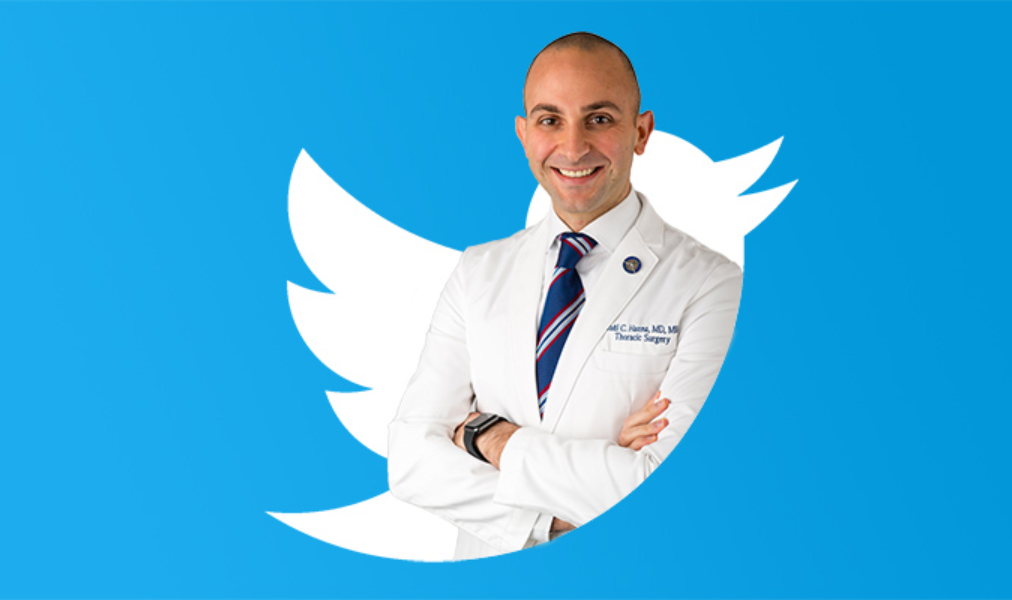The more you tweet, the higher your impact

Waël Hanna is an associate professor in the Department of Surgery at McMaster University. (Graphic design by Cameron Taylor.)
BY Tina Depko, Health Sciences
February 7, 2019
To tweet, or not to tweet, that is the question.
According to a study from McMaster University, academic thoracic surgeons who are already on Twitter should choose to share their research in 280 characters if they are looking to get noticed.
A team of researchers at the university found that the more you tweet, the better your research citation index.
An abstract of the study results was shared during a recent poster session at the Society of Thoracic Surgeon’s Annual Meeting in San Diego.
“We started noticing thoracic surgeons who are engaged on Twitter were suddenly getting invited to be keynote speakers at conferences, etc., but there was no information available on their scientific impact except anecdotes and stories,” said Waël Hanna, principal investigator of the study, associate professor in the Department of Surgery, and a thoracic surgeon at St. Joseph’s Healthcare Hamilton. “We decided to look at the correlation between your activity on Twitter and your h-index.”
The h-index, formally known as the Hirsch-index, is a common metric used to evaluate a researcher’s productivity and influence.
More than 3,700 thoracic surgeons registered on CTSnet.org in Canada and the United States were queried for profiles with an h-index on Google Scholar and/or ResearchGate in July 2018. Of the 722 surgeons found with an h-index, 188 were on Twitter, while the remainder of the 534 were not.
The research team focused on the 95 per cent, or 686, on ResearchGate.
Based on the 686 surgeons, the mean h-index for the entire cohort was 14.54. The median h-index was 10 and the 75th percentile h-index was 20.
The mean for surgeons on Twitter was 15.02, compared to 14.86 for surgeons not on Twitter. The 75th percentile h-index was 23, compared to 20, respectively for these two groups.
Researchers summarized that the Twitter usage of North American thoracic surgeons showed no significant difference in h-index values between those who use Twitter versus those who do not.
However, they also concluded that among surgeons who use Twitter, those who tweet more frequently, follow more people, and have a greater following are more likely to have their research cited by others, and consequently have a higher h-index than their counterparts.
The study with more extensive data has been submitted for publication.
Hanna noted that while the study provides scientific impact, there are still outstanding questions that he hopes others will look to answer.
“Is that surgeon’s h-index high because they are a brilliant surgeon, and because they are brilliant, is their research being talked about on Twitter? Or is it because they are advertising themselves so much on Twitter they become part of the subconscious of everybody else and they are quoted because of that?” he said. “It is hard to prove causation, but it is easy to prove correlation.”
Regardless, Hanna said the study has made an impact on his own digital footprint.
“I am personally now more active on Twitter,” he said. “I also hired a company to design a website, and help ensure I am uniform in my messaging, branding and identity. My feed is mostly about research related to lung cancer. Patients do follow me and comment on my posts.”
He said that he anticipates that social media, and Twitter, in particular, will become increasingly used by thoracic surgeons to communicate with current and prospective patients in the coming years.
“The lung cancer population, for example, is older, as the demographic of the disease is generally between 60 and 80, so they are not normally on social media,” he said. “However, in the next decade, the 50-year-olds now on social media are going to become the lung cancer demographic. It’s going to be one ways of how we as doctors can and should communicate.”
All researchers on the study came from the Division of Thoracic Surgery in the Department of Surgery at McMaster. You can connect with McMaster’s division of Thoracic Surgery at @MacThoracics.
There was no external funding for the study.
Poster details for the study are available on page 224 of the abstract book here.


